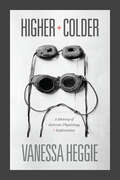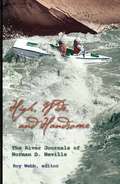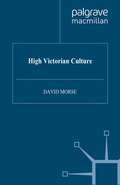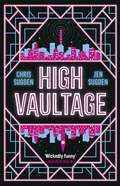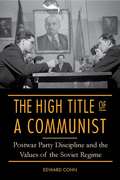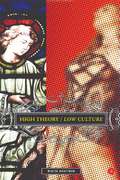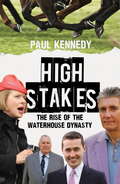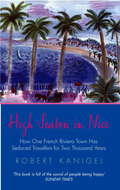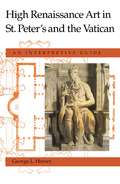- Table View
- List View
Higher and Colder: A History of Extreme Physiology and Exploration
by Vanessa HeggieDuring the long twentieth century, explorers went in unprecedented numbers to the hottest, coldest, and highest points on the globe. Taking us from the Himalaya to Antarctica and beyond, Higher and Colder presents the first history of extreme physiology, the study of the human body at its physical limits. Each chapter explores a seminal question in the history of science, while also showing how the apparently exotic locations and experiments contributed to broader political and social shifts in twentieth-century scientific thinking. Unlike most books on modern biomedicine, Higher and Colder focuses on fieldwork, expeditions, and exploration, and in doing so provides a welcome alternative to laboratory-dominated accounts of the history of modern life sciences. Though centered on male-dominated practices—science and exploration—it recovers the stories of women’s contributions that were sometimes accidentally, and sometimes deliberately, erased. Engaging and provocative, this book is a history of the scientists and physiologists who face challenges that are physically demanding, frequently dangerous, and sometimes fatal, in the interest of advancing modern science and pushing the boundaries of human ability.
The Highborn Housekeeper (Saved from Disgrace #3)
by Sarah MalloryA disgraced lady Turned lowly housekeeper
High Wide And Handsome: The River Journals of Norman D. Nevills
by Roy WebbWhen he started taking paying passengers by boat through the rapids of the Colorado River's canyons, Norman Nevills invented whitewater tourism and the commercial river business. For twelve years, from 1938 until his death in a plane crash in 1949, he safely took, without a single life lost, friends, explorers, and customers down the Colorado, Green, San Juan, Salmon, and Snake Rivers in boats he designed. National media found him and his adventures irresistible and turned him into the personification of river running. Logging seven trips through the Grand Canyon when no one else had completed more than two, he was called the Fast Water Man. Boatmen he trained went on to found their own competing operations. Always controversial, Nevills had important critics and enemies as well as friends and supporters, but no one can dispute his tremendous impact on the history of western rivers and recreation. Nevills's complete extant journals of those river expeditions are published for the first time in High, Wide, and Handsome. They contain vivid stories and images of still untamed-by-dams rivers and canyons in the Colorado River system and elsewhere, of wild rides in wooden boats, and of the few intrepid pioneers of adventure tourism who paid Nevills so they could experience it all. They have been transcribed and edited by river historian Roy Webb, author of If We Had a Boat: Green River Explorers, Adventurers, and Runners and Call of the Colorado.
High Water
by Douglas ReemanPhillip Vivian finds himself trapped in a treacherous web of violence in this enthralling novel classic from the master of the modern sea story, Douglas Reeman; he has also written over twenty bestselling novels featuring Richard Bolitho, under the pseudonym Alexander Kent.With his own boat, the motor yacht Sea Fox, former naval officer Philip Vivian had hoped to earn a living free from the petty restrictions of everyday life, close to the sea he loved.Now, however, his dream is threatened by financial difficulties. So when a profitable, if legally dubious, proposition is put to him by an old naval comrade in arms, Vivian is willing to listen.But what starts out as a harmless adventure soon turns into something altogether more sinister. And Vivian finds himself trapped in a treacherous web of violence and crime, dangerously torn between his stubborn sense of past loyalties and his duty to a society he has always despised.
High Victorian Design: A Study of the Exhibits of 1851
by Dr. Nikolaus Pevsner'Thirst for information, faith in commerce and industry, inventiveness and technical daring, energy and tenacity, and a tendency to mix up religion with visible success - all these qualities have to be remembered as one embarks on a conducted tour of some of the exhibits of 1851.'The Great Exhibition of 1851 at the Crystal Palace was opened by Queen Victoria and would attract more than six million visitors. Writing one hundred years later, Nikolaus Pevsner makes a brilliant survey of what the Exhibition - 'the final flourish of a century of great commercial expansion' - offered to posterity as the hallmarks of High Victorian Design; also as windows into the mentality of mid-nineteenth-century England.
High Victorian Culture
by D. Morse'...an illuminating survey work by a robust and powerful intelligence with an impressive grasp of a great deal of material.' Tony Tanner, The Times Literary Supplement High Victorian Culture is an in-depth study of Victorian Literature and culture in its heyday, from the accession to the throne by Queen Victoria in 1837 to her proclamation as Empress of India in 1877 - the age of Dickens, Carlyle, Mill, George Eliot, Tennyson and Browning. It is a time of growing national self-confidence and of impressive industrial, scientific and literary achievements; yet it is also an age marked by dislocation and uncertainty. Freedom of speech and openness of discussion were values on which Victorians ostensibly prided themselves, yet the actual prospect was one which high victorian culture found deeply troubling.
High Vaultage: ‘High Vaultage positively crackles with invention and intrigue!’ – Helen Marshall
by Chris Sugden Jen SugdenEVEN GREATER LONDON, 1887. An uninterrupted urban plane encompassing the entire lower half of England and, for complex reasons, only the upper third of the Isle of Wight. The immense Tower casts electricity through the sky, powering the mind-boggling mechanisms of the city. The engineer-army of Isambard Kingdom Brunel swarms across the capital, building, demolishing, and rebuilding whatever they see fit. And at the heart of it all sits the country's first private detective agency.Archibald Fleet and Clara Entwhistle hoped things would pick up quickly for their new enterprise. No-one is taking them seriously, but their break will come soon. Definitely. Probably.Meanwhile, police are baffled by a series of impossible bank robberies, their resources absorbed by the case. Which means that when a woman witnesses a kidnapping, Fleet-Entwhistle Private Investigations is the only place she can turn for help. They're more than happy to oblige!But what's the motive behind the kidnap? As Clara and Fleet investigate, they find more than they could ever have imagined . . .From the creators of the acclaimed audio drama podcast Victoriocity comes a hilarious novel set in the greatest, most chaotic city in history. Twisty, inventive, and joyously funny, High Vaultage is perfect for fans of Ben Aaronovitch, Douglas Adams, and Terry Pratchett.
The High Title of a Communist: Postwar Party Discipline and the Values of the Soviet Regime
by Edward CohnBetween 1945 and 1964, six to seven million members of the Communist Party of the Soviet Union were investigated for misconduct by local party organizations and then reprimanded, demoted from full party membership, or expelled. Party leaders viewed these investigations as a form of moral education and used humiliating public hearings to discipline wrongdoers and send all Soviet citizens a message about how Communists should behave. The High Title of a Communist is the first study of the Communist Party's internal disciplinary system in the decades following World War II.Edward Cohn uses the practices of expulsion and censure as a window into how the postwar regime defined the ideal Communist and the ideal Soviet citizen. As the regime grappled with a postwar economic crisis and evolved from a revolutionary prewar government into a more bureaucratic postwar state, the Communist Party revised its informal behavioral code, shifting from a more limited and literal set of rules about a party member's role in the economy to a more activist vision that encompassed all spheres of life. The postwar Soviet regime became less concerned with the ideological orthodoxy and political loyalty of party members, and more interested in how Communists treated their wives, raised their children, and handled their liquor. Soviet power, in other words, became less repressive and more intrusive. Cohn uses previously untapped archival sources and avoids a narrow focus on life in Moscow and Leningrad, combining rich local materials from several Russian provinces with materials from throughout the USSR. The High Title of a Communist paints a vivid portrait of the USSR's postwar era that will help scholars and students understand both the history of the Soviet Union's postwar elite and the changing values of the Soviet regime. In the end, it shows, the regime failed in its efforts to enforce a clear set of behavioral standards for its Communists—a failure that would threaten the party's legitimacy in the USSR's final days.
High Theory/Low Culture
by M. BrottmanIn High Theory/Low Culture , Brottman uses the tools of 'high' cultural theory to examine many areas of today's popular culture, including style magazines, sport, shopping, tabloid newspapers, horror movies and pornography. In doing so, she not only demonstrates the practical use of 'high' theory as it relates to our everyday world, but she also investigates the kinds of 'low' culture that are regularly dismissed by academic scholars. Through a close examination of these cultural forms, Brottman reveals how the kinds of popular culture that we usually take for granted are, in fact, far more complex and sophisticated than is normally assumed.
High Tea on the Cunard Queens: A Light-hearted Look at Life at Sea
by Paul CurtisThis amusing insight into Cunard’s legendary liners begins more than fifty years ago when the author joined the original Queen Mary as an entertainments officer, when a part of the job was ‘bumbling’ the passengers while keeping a wary eye out for professional gamblers criss-crossing the Atlantic, and there was bingo and dance bands, novelty dancing and fancy-dress parades, and a primitive disco with a monster juke box. Paul Curtis recounts the stories of the ships, the antics of passengers and crews, and much more besides. Just turning these pages releases a sniff of the sea and a whiff of champagne. This frank and funny account of mixes Cunard history with personal anecdote and vividly reveals how passenger and crew life have changed over the years across the Cunard liners.
High Street: Book Two in the gripping, uplifting Gibson Family Saga (Gibson Saga)
by Anna Jacobs**Book two in the gorgeously heartwarming Gibson Family series, perfect for fans of Catherine Cookson, Dilly Court and 'Call the Midwife'**Lancashire, 1845. Annie Gibson can finally leave Salem Street. At long last she's realised her dream of opening an elegant dressmaking salon in the mill town of Bilsden - and she is determined to take her father and his second family with her, away from poverty. But Annie's troubles are far from over. Someone is trying to undermine her business; her family have their own ideas about what they want to do with their lives; and several men are persistently trying to win her favour, including Frederick, the mill owner, and Daniel, her childhood friend.As Annie gets better acquainted with both, she becomes increasingly confused about her feelings. Can she really be in love? And can she risk trusting any man ever again?**************Praise for Anna Jacobs: 'Catherine Cookson fans will cheer!' - Peterborough Evening Telegraph'Anna Jacobs' books are deservedly popular. She is one of the best writers of Lancashire sagas around' - Historical Novels Reviews'Anna Jacobs' books have an impressive grasp of human emotions' - Sunday Times
High Stakes: The rise of the Waterhouse dynasty
by Paul Kennedy'This history of the Waterhouse dynasty is a cut above the field of racing books that burst from the barriers this time of year' - Sydney Morning HeraldDrama, glamour, scandal, success - and very high stakes. The story of Australia's best known horse racing family has it all.When it comes to racing, the name most Australians associate with the racetrack is Waterhouse. This is their compelling story.High Stakes takes us from Bill Waterhouse's introduction to the world as a sixteen-year-old, working as a bookmaker for his father in the late thirties - going on to make money both on and off the track - to the headlines caused by his involvement in the notorious Fine Cotton affair in the eighties.It examines his son Robbie's rise as a respected bookie and a knowledgeable judge of horses, to his spectacular fall, as a result of that same Fine Cotton affair, which led to a life ban from involvement in the racing industry. While the ban was lifted in 2001, he keeps a low profile these days. As Kennedy reveals, the same cannot be said of Robbie's wife, Gai, daughter of the legendary horse trainer TJ Smith. In a male-dominated world, she has gone on to rival her father as one of Australia's best trainers, training horses for a star-studded clientele that has ranged from John Singleton to the Queen of England.Yet as High Stakes shows, the scandal aside, the marriage between Gai and Robbie was always going to be problematic. As the Sydney Morning Herald put it: 'It's not that the Smiths and the Waterhouses were necessarily the Capulets and the Montagues but the country's leading trainer and the world's biggest bookmaker were hardly natural kinsfolk either.'Despite an already colourful history, when their son, Tom, stepped into the family business and became one of the best-known and most controversial bookies the country had ever seen, Kennedy describes how the dramas for the Waterhouse dynasty were only just beginning...This is the book for anyone who wants to know the inside story of contemporary Australian horse racing, a world where premiers and millionaires rub shoulders with gangsters and girls with fancy hats. It's a world of passion, action - and very high stakes.
High-Speed Dreams: NASA and the Technopolitics of Supersonic Transportation, 1945–1999 (New Series in NASA History (PDF))
by Erik M. ConwayIn High-Speed Dreams, Erik M. Conway constructs an insightful history that focuses primarily on the political and commercial factors responsible for the rise and fall of American supersonic transport research programs. Conway charts commercial supersonic research efforts through the changing relationships between international and domestic politicians, military/NASA contractors, private investors, and environmentalists. He documents post-World War II efforts at the National Advisory Committee on Aeronautics and the Defense Department to generate supersonic flight technologies, the attempts to commercialize these technologies by Britain and the United States during the 1950s and 1960s, environmental campaigns against SST technology in the 1970s, and subsequent attempts to revitalize supersonic technology at the end of the century.High-Speed Dreams is a sophisticated study of politics, economics, nationalism, and the global pursuit of progress. Historians, along with participants in current aerospace research programs, will gain valuable perspective on the interaction of politics and technology.
High Season In Nice
by Robert KanigelNice is the queen of the Côte d'Azur. Founded by the Greeks some time after the sixth century BC, it has borne the tread of Roman legionnaires and Italy-bound Englishmen on the Grand Tour as well as Lost Generation literati from Hemingway to Fitzgerald. Since the late nineteenth century it has been known as a 'pleasure capital', and now tourism is its beating heart. But how did this happen? What was it that changed not just Nice or the French Riviera, but our leisure habits as a whole?HIGH SEASON is a book about pleasure and escape - about what five months or five days in a strikingly beautiful, foreign place, wrested from lives choked with stress and toil back home, meant to a few wealthy people 250 years ago, and mean to millions more of more modest means today. It is about how modern tourism got the way it did. It is about how Nice and the Riviera became what they are; and about the price they paid to do so.
High Seas to High Society: High Seas To High Society / One Unashamed Night / One Illicit Night / The Dissolute Duke (Mills And Boon Historical Ser.)
by Sophia JamesAsher Wellingham, Duke of Carisbrook, was captivated by her! He had happened upon Lady Emma Seaton swimming naked and, beyond her beauty, had seen the deep curling scar on her thigh–a wound that could only be the mark of a sword. Who was this creature of contradictions? Something about her brought back tantalizing memories from the past.
High Seas Stowaway (Mills And Boon Superhistorical Ser.)
by Amanda McCabeIndulge your fantasies of delicious Regency Rakes, fierce Viking warriors and rugged Highlanders. Be swept away into a world of intense passion, lavish settings and romance that burns brightly through the centuries Pirates, passion and danger on the high seas!
The High Road to China: George Bogle, The Panchen Lama, And The First British Expedition To Tibet
by Kate TeltscherIn 1774 British traders longed to open relations with China so they sent a young Scotsman, George Bogle, as an envoy to Tibet. Bogle became smitten by what he saw there, and struck up a remarkable friendship with the Panchen Lama. This gripping book tells the story of their two extraordinary journeys across some of the harshest and highest terrain in the world: Bogle's mission, and the Panchen Lama's state visit to China, on which British hopes were hung. Piecing together extracts from Bogle's private papers, Tibetan biographies of the Panchen Lama, the account of a wandering Hindu monk and the writings of the Emperor himself, Kate Teltscher deftly reconstructs the momentous meeting of these very different worlds.
High Renaissance Art In St. Peter's And The Vatican: An Interpretive Guide
by George L. HerseyMichelangelo, Raphael, Bramante--together these artists created some of the most glorious treasures of the Vatican, viewed daily by thousands of tourists. But how many visitors understand the way these artworks reflect the passions, dreams, and struggles of the popes who commissioned them? For anyone making an artistic pilgrimage to the High Renaissance splendors of the Vatican, George L. Hersey's book is the ideal guide. Before starting the tour of individual works, Hersey describes how the treacherously shifting political and religious alliances of sixteenth-century Italy, France, and Spain played themselves out in the Eternal City. He offers vivid accounts of the lives and personalities of four popes, each a great patron of art and architecture: Julius II, Leo X, Clement VII, and Paul III. He also tells of the complicated rebuilding and expanding of St. Peter's, a project in which Bramante, Raphael, and Michelangelo all took part. Having set the historical scene, Hersey then explores the Vatican's magnificent Renaissance art and architecture. In separate chapters, organized spatially, he leads the reader through the Cortile del Belvedere and Vatican Museums, with their impressive holdings of statuary and paintings; the richly decorated Stanze and Logge of Raphael; and Michelangelo's Last Judgment and newly cleaned Sistine Chapel ceiling. A fascinating final chapter entitled "The Tragedy of the Tomb" recounts the vicissitudes of Michelangelo's projected funeral monument to Julius II. Hersey is never content to simply identify the subject of a painting or sculpture. He gives us the story behind the works, telling us what their particular themes signified at the time for the artist, the papacy, and the Church. He also indicates how the art was received by contemporaries and viewed by later generations. Generously illustrated and complete with a useful chronology, High Renaissance Art in St. Peter's and the Vatican is a valuable reference for any traveler to Rome or lover of Italian art who has yearned for a single-volume work more informative and stimulating than ordinary guidebooks. At the same time, Hersey's many anecdotes and intriguing comparisons with works outside the Vatican will provide new insights even for specialists.
High Renaissance Art in St. Peter's and the Vatican: An Interpretive Guide
by George L. HerseyMichelangelo, Raphael, Bramante—together these artists created some of the most glorious treasures of the Vatican, viewed daily by thousands of tourists. But how many visitors understand the way these artworks reflect the passions, dreams, and struggles of the popes who commissioned them? For anyone making an artistic pilgrimage to the High Renaissance splendors of the Vatican, George L. Hersey's book is the ideal guide. Before starting the tour of individual works, Hersey describes how the treacherously shifting political and religious alliances of sixteenth-century Italy, France, and Spain played themselves out in the Eternal City. He offers vivid accounts of the lives and personalities of four popes, each a great patron of art and architecture: Julius II, Leo X, Clement VII, and Paul III. He also tells of the complicated rebuilding and expanding of St. Peter's, a project in which Bramante, Raphael, and Michelangelo all took part. Having set the historical scene, Hersey then explores the Vatican's magnificent Renaissance art and architecture. In separate chapters, organized spatially, he leads the reader through the Cortile del Belvedere and Vatican Museums, with their impressive holdings of statuary and paintings; the richly decorated Stanze and Logge of Raphael; and Michelangelo's Last Judgment and newly cleaned Sistine Chapel ceiling. A fascinating final chapter entitled "The Tragedy of the Tomb" recounts the vicissitudes of Michelangelo's projected funeral monument to Julius II. Hersey is never content to simply identify the subject of a painting or sculpture. He gives us the story behind the works, telling us what their particular themes signified at the time for the artist, the papacy, and the Church. He also indicates how the art was received by contemporaries and viewed by later generations. Generously illustrated and complete with a useful chronology, High Renaissance Art in St. Peter's and the Vatican is a valuable reference for any traveler to Rome or lover of Italian art who has yearned for a single-volume work more informative and stimulating than ordinary guidebooks. At the same time, Hersey's many anecdotes and intriguing comparisons with works outside the Vatican will provide new insights even for specialists.
High-Profile Crimes: When Legal Cases Become Social Causes
by Lynn S. ChancerO. J. Simpson. The Central Park jogger. Bensonhurst. William Kennedy Smith. Rodney King. These are more than crimes and criminals, more than court cases. They are cultural events that, for better or worse, gave concrete expression to latent social conflicts in American society. In High-Profile Crimes, Lynn Chancer explores how these cases became conflated with larger social causes on a collective level and how this phenomenon has affected the law, the media, and social movements. An astute and incisive chronicle of some of the most polarizing cases of the 1980s and 1990s, High-Profile Crimes shows that their landmark status results from the overlapping interaction of diverse participants. The merging of legal cases and social causes, Chancer argues, has wrought ambivalent effects on both social movements and the law. On the one hand, high-profile crimes offer important opportunities for emotional expression and raise awareness of social issues. But on the other hand, social problems cannot be resolved through the either/or determinations that are the goals of the legal system, creating frustration for those who look to the outcome of these cases for social progress. Guilt or innocence through the lens of the media leads to either defeat or victory for a social cause-a confounding situation that made the O. J. Simpson case, for example, unable to resolve the issues of domestic violence and police racism that it had come to symbolize. Based on nearly two hundred interviews, Chancer's discussions of the infamous Central Park jogger and Bensonhurst cases-as well as the rape trials of William Kennedy Smith and Mike Tyson, the assault cases of Rodney King and Reginald Denny, and, finally, the O. J. Simpson murder trial-provide a convincing, multidimensional and innovative analysis of the most charged public dramas of the last two decades.
High-Profile Crimes: When Legal Cases Become Social Causes
by Lynn S. ChancerO. J. Simpson. The Central Park jogger. Bensonhurst. William Kennedy Smith. Rodney King. These are more than crimes and criminals, more than court cases. They are cultural events that, for better or worse, gave concrete expression to latent social conflicts in American society. In High-Profile Crimes, Lynn Chancer explores how these cases became conflated with larger social causes on a collective level and how this phenomenon has affected the law, the media, and social movements. An astute and incisive chronicle of some of the most polarizing cases of the 1980s and 1990s, High-Profile Crimes shows that their landmark status results from the overlapping interaction of diverse participants. The merging of legal cases and social causes, Chancer argues, has wrought ambivalent effects on both social movements and the law. On the one hand, high-profile crimes offer important opportunities for emotional expression and raise awareness of social issues. But on the other hand, social problems cannot be resolved through the either/or determinations that are the goals of the legal system, creating frustration for those who look to the outcome of these cases for social progress. Guilt or innocence through the lens of the media leads to either defeat or victory for a social cause-a confounding situation that made the O. J. Simpson case, for example, unable to resolve the issues of domestic violence and police racism that it had come to symbolize. Based on nearly two hundred interviews, Chancer's discussions of the infamous Central Park jogger and Bensonhurst cases-as well as the rape trials of William Kennedy Smith and Mike Tyson, the assault cases of Rodney King and Reginald Denny, and, finally, the O. J. Simpson murder trial-provide a convincing, multidimensional and innovative analysis of the most charged public dramas of the last two decades.
A High Price: The Triumphs and Failures of Israeli Counterterrorism
by Daniel BymanThe product of painstaking research and countless interviews, A High Price offers a nuanced, definitive historical account of Israel's bold but often failed efforts to fight terrorist groups. Beginning with the violent border disputes that emerged after Israel's founding in 1948, Daniel Byman charts the rise of Yasir Arafat's Fatah and leftist groups such as the Popular Front for the Liberation of Palestine--organizations that ushered in the era of international terrorism epitomized by the 1972 hostage-taking at the Munich Olympics. Byman reveals how Israel fought these groups and others, such as Hamas, in the decades that follow, with particular attention to the grinding and painful struggle during the second intifada. Israel's debacles in Lebanon against groups like the Lebanese Hizballah are examined in-depth, as is the country's problematic response to Jewish terrorist groups that have struck at Arabs and Israelis seeking peace. In surveying Israel's response to terror, the author points to the coups of shadowy Israeli intelligence services, the much-emulated use of defensive measures such as sky marshals on airplanes, and the role of controversial techniques such as targeted killings and the security barrier that separates Israel from Palestinian areas. Equally instructive are the shortcomings that have undermined Israel's counterterrorism goals, including a disregard for long-term planning and a failure to recognize the long-term political repercussions of counterterrorism tactics.
A High Price: The Triumphs and Failures of Israeli Counterterrorism
by Daniel BymanThe product of painstaking research and countless interviews, A High Price offers a nuanced, definitive historical account of Israel's bold but often failed efforts to fight terrorist groups. Beginning with the violent border disputes that emerged after Israel's founding in 1948, Daniel Byman charts the rise of Yasir Arafat's Fatah and leftist groups such as the Popular Front for the Liberation of Palestine--organizations that ushered in the era of international terrorism epitomized by the 1972 hostage-taking at the Munich Olympics. Byman reveals how Israel fought these groups and others, such as Hamas, in the decades that follow, with particular attention to the grinding and painful struggle during the second intifada. Israel's debacles in Lebanon against groups like the Lebanese Hizballah are examined in-depth, as is the country's problematic response to Jewish terrorist groups that have struck at Arabs and Israelis seeking peace. In surveying Israel's response to terror, the author points to the coups of shadowy Israeli intelligence services, the much-emulated use of defensive measures such as sky marshals on airplanes, and the role of controversial techniques such as targeted killings and the security barrier that separates Israel from Palestinian areas. Equally instructive are the shortcomings that have undermined Israel's counterterrorism goals, including a disregard for long-term planning and a failure to recognize the long-term political repercussions of counterterrorism tactics.
High Plains Wife (Mills And Boon Historical Ser.)
by Jillian HartMontana's Wide Open Plains Were As Empty As Her Newlywed Heart. Rancher Nick Gray, once Mariah's girlhood crush, wanted a mother to tend his children, not a wife to warm his bed. Still, she'd made that bed; now Mariah had to lie in it. Yet could she bear to lie in it alone?
High Plains Horticulture: A History
by John F. FreemanHigh Plains Horticulture explores the significant, civilizing role that horticulture has played in the development of farmsteads and rural and urban communities on the High Plains portions of Colorado, Kansas, Nebraska, South Dakota, and Wyoming, drawing on both the science and the application of science practiced since 1840. Freeman explores early efforts to supplement native and imported foodstuffs, state and local encouragement to plant trees, the practice of horticulture at the Union Colony of Greeley, the pioneering activities of economic botanists Charles Bessey (in Nebraska) and Aven Nelson (in Wyoming), and the shift from food production to community beautification as the High Plains were permanently settled and became more urbanized. In approaching the history of horticulture from the perspective of local and unofficial history, Freeman pays tribute to the tempered idealism, learned pragmatism, and perseverance of individuals from all walks of life seeking to create livable places out of the vast, seemingly inhospitable High Plains. He also suggests that, slowly but surely, those that inhabit them have been learning to adjust to the limits of that fragile land. High Plains Horticulture will appeal to not only scientists and professionals but also gardening enthusiasts interested in the history of their hobby on the High Plains.
